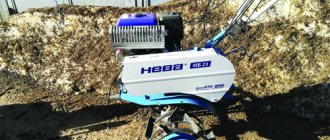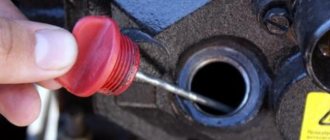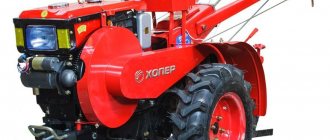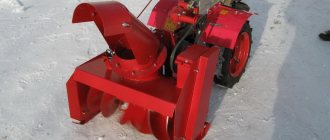Motoblocks and cultivators are the main helpers of farmers
As you know, growing vegetables and fruits requires huge physical costs and time, and the use of a walk-behind tractor or a cultivator allows you to save both of these precious resources.
We are talking about a technique with a democratic cost, which is designed to cultivate the land and perform a number of related tasks. They are usually powered by gasoline engines, but there are also electric models on the market that are suitable for working in small garden areas.
Motoblocks and cultivators on gasoline are more powerful and durable, which allows them to cultivate agricultural land up to 2-3 hectares. These are reliable units with simple and clear control, economical fuel consumption and high functionality. Here is the main list of their tasks (varies depending on the modification):
- Plowing the soil after winter;
- soil cultivation;
- Cutting rows for subsequent sowing;
- Hilling seedlings;
- Weeding beds;
- Potato harvesting;
- Weed mowing and lawn mowing;
- Clearing the ground from snow.
The list of work in progress is the main criterion for choosing a device. Before buying, you should determine the scope and types of tasks, and then, based on the findings, decide what is right for you, a walk-behind tractor or a cultivator.
What to choose: main conclusions
If it is difficult for you to choose a walk-behind tractor or a cultivator, then focus on exactly what purposes such equipment is needed for. After all, a walk-behind tractor is more functional. It can handle a wide range of agricultural tasks with ease. In addition, such a device can be combined with other attachments and thereby increase the number of functions - make it a tractor for transporting goods, a snow blower, and so on. On the other hand, a cultivator can also have an advantage over a walk-behind tractor. But in case you plan to use such a device in small areas, where, apart from weeding, fluffing the soil and inter-row cultivation, nothing is required.
Differences between walk-behind tractors and cultivators
A summary of the comparative analysis of walk-behind tractors and cultivators can be found in the table below.
| Cultivators | Motoblocks | |
| Weight | 20-60 kg | From 70 kg |
| Power | 3-6 hp | 7−12 hp |
| Frame | Stiffness characteristics depend on the power of the model | Reinforced massive frame made of durable metal alloys |
| Transmission | There is only one gear and the option to select the direction of rotation of the cutters | Minimum box set: 2 forward and 1 reverse gear |
| PTO | No | Eat |
| wheels | Ordinary, but there are also expensive models with pneumatic wheels | Almost all options are equipped with pneumatic wheels |
| Milling function | The main method of soil treatment | Included in the number of applied methods of tillage |
| Working with hillers | Only weighted aggregates are capable of this, but even they can only cope with light soils. | Capable of working with double hillers |
| Working with a plow | No | Can work with a plow on different types of soils |
| Potato digger compatibility | No | Yes |
| Work with active attachments (mower, snow blower, etc.) | No | Yes, if the model is equipped with a PTO |
| Transport work | Can be converted, but there is no reason for this | Can play the role of transport |
Motoblocks - a better offer or a waste of money?
Motoblocks are more functional agricultural machinery. That is, with such a unit, you can quickly and better perform a greater number of different jobs.
You can only cultivate the land with a motor-cultivator, and the main difference between a motor-block is its versatility. You will be able to water plants, plant and harvest crops, mow grass, remove snow, transport goods… The list goes on and on. In addition, the power of such machines is an order of magnitude higher, but here the fuel costs will be higher.
Motoblocks are real hard workers that make life much easier for farmers and agrarians. If your plot is large enough, then a motor cultivator simply will not suit you - it will not cope with the loads.
Motoblocks also come in different types, and run on diesel or gasoline. It all depends on your financial capabilities, as well as on the tasks that the machine will have to cope with.
Features of motor cultivators
Popular garden equipment powered by gasoline. The power range of such engines varies from 3 to 6 horsepower, and the maximum mass of the unit is about 60 kg.
At the same time, the weight varies greatly: along with heavyweights, there are lightweight models weighing about 20 kg on the market. In addition, the weight of the device sometimes increases to 100 kg if ballast weights are involved. They are mounted on the main body to work on heavy soils and perform specific tasks.
Motor cultivators are able to cope with a limited range of problems:
- Weeding;
- Soil fluffing;
- Processing of inter-row space;
- Hilling (not all models).
Motor cultivators weighing up to 50 kg are purchased for processing summer cottages with an area of \u200b\u200bup to 20 acres. With their help, you can also facilitate the care of greenhouses, flower beds and lawns.
The main working element of each cultivator is a rotating sectional cutter, the width of which varies from 35 to 70 cm. This parameter can be changed by adding or removing sections. This is useful if the width of the cultivated areas between the rows is different.
The working cutter at the same time sets the unit in motion: clinging to the soil, it pulls the cultivator body forward. The speed of movement is regulated by means of the throttle handle.
As for the gearboxes that modern models of motor cultivators are equipped with, they can be of different types: gear or CVT. The reverse may or may not be present, depending on the model.
Usually heavyweights from 50 kg have a gearbox, but even if the manufacturer has installed a gearbox, it is unlikely to have more than two gears - reverse and front.
Heavy models allow you to replace the cutter with metal wheels with lugs. Such "tuning" will give the opportunity to use trailed equipment, such as hillers or a plow. However, in practice, a rare motor cultivator, even with an impressive mass, can easily cope with plowing. Potato hilling can still be done, but only on light ground. Heavy soils are not for motor cultivators.
Summarizing the characteristics described above, we can conclude that cultivators are ideal for small-scale private summer cottages. They will be enough for loosening the soil before planting and for processing inter-row zones.
Show prices for cultivators
Comparison
Combining the main characteristics in one table will help to move on to the choice in the future:
| Motoblock | Cultivator |
| Multifunctionality | Limited in functions |
| Weight from 80 to 150 kg. | Weight from 20 to 50 kg. |
| Power over 12 hp | Power is not more than 3-6 hp. |
| Lots of attachments, gears and speeds | Minimum modes |
| High fuel consumption | Low fuel consumption |
| Capture width 60-90 cm | Capture width 30-110 cm |
| Potential maintenance difficulties | Maximum ease of maintenance |
| Capture depth over 30 cm | Capture depth up to 20 cm |
Based on this comparison, it is clearly seen that the performance and functionality of the walk-behind tractor is much higher, as well as the cost. The average price for a cultivator is from 3 to 25 thousand rubles. The price of a walk-behind tractor starts at about 27 thousand rubles and grows further.
Motoblocks
If, when comparing cultivators and walk-behind tractors, we draw an analogy with vehicles, then the former will be passenger cars, and the latter will be caterpillar tractors.
Each category has its pros and cons, as well as strictly defined functionality. If we take the same tasks for comparison, then the walk-behind tractor will no doubt cope with them easier and faster than a cultivator, but at the same time it will “eat” much more fuel and physical effort required for control.
So, walk-behind tractors are heavier equipment, designed more for farmers than for amateur gardeners.
They run on gasoline and diesel engines, with light and medium models from 50 to 150 kg running on gasoline, and heavyweights on diesel, whose weight can be about 300 kg. Light motoblocks have a power of up to 6 horsepower, medium ones - about 8, and the indicator of heavy models varies from 8 to 12 horses.
The key distinguishing feature of walk-behind tractors is the equipment with pneumatic tires and power take-off shafts, with which you can connect attachments that significantly expand the functionality of the unit. Available accessories include different types of cutters, wood splitters, mowers, pumps, etc. As for pneumatic wheels, they are used not only in working, but also in transport mode.
Another notable feature of this category of agricultural machinery is the presence of a complex gearbox, in which reverse gear is necessarily present.
The maximum number of gears can be equal to the arsenal of an ordinary passenger car and even exceed it (4-5 forward and 2 reverse speeds). However, most models available on the Russian market have up to 4 gears, and they are quite enough for the entire list of available functions.
The motor is started in manual mode or using an electric starter - the second option is implemented on professional equipment, which increases its cost at times.
Motoblocks are compatible with all types of agricultural implements, so any work on the site is available to them:
- Plowing;
- cultivation;
- grass bevel;
- Digging up potatoes and more.
In addition to earthworks, walk-behind tractors can serve as transport. The lion's share of models is equipped with trailers in the form of carts, in which you can transport goods weighing up to 1 ton. The maximum speed of such walk-behind tractors reaches 12 km / h.
Heavy and medium walk-behind tractors have a lockable differential, which expands their functionality to work with heavy soils, wet grass and eroded soil. They can easily move over uneven arable land and carry the equipment you need, fertilizers and other agricultural belongings.
There are also transitional options on the market, the parameters of which are similar to walk-behind tractors, but they are not equipped with a power take-off shaft. At their core, these are heavy wheeled cultivators. Due to the existence of such mixed models, it is quite difficult to draw a clear line between motor cultivators and motor blocks. However, even such intermediate options find their audience, which needs the combined properties of both categories.
Show prices for walk-behind tractors
What is better cultivator or walk-behind tractor?
A walk-behind tractor and a cultivator are, in fact, completely different units. The purpose of the cultivator is only in the cultivation of the soil, i.e. the land cultivated by the cultivator becomes softer, the roots of various weeds are destroyed by grinding. There are cultivators with a gasoline or electric engine. It is worth noting that, except for cultivating the soil, the cultivator is no longer good for anything.
Husqvarna cultivator
A motoblock is a more functional tool. Its purpose can be significantly expanded by installing additional devices on it. For example, a walk-behind tractor can be equipped with a cultivator, plow or hiller. If you install wheels on it, it will turn into a small tractor capable of carrying any cargo. In addition, the walk-behind tractor can work as an electric generator, mower, water pump and much more. Moreover, the replacement of devices is quite simple and, as a rule, does not take more than 10-15 minutes.
Usually, the basic equipment of a walk-behind tractor includes only a cultivator and wheels. All other required accessories will have to be purchased separately. Therefore, if you only need soil cultivation, then it is better to buy a cultivator, since a walk-behind tractor will cost significantly more.
However, walk-behind tractors are often purchased precisely because of their great functionality. With the help of a walk-behind tractor, you can cultivate the land where even a small tractor will not enter, for example, in a greenhouse.











